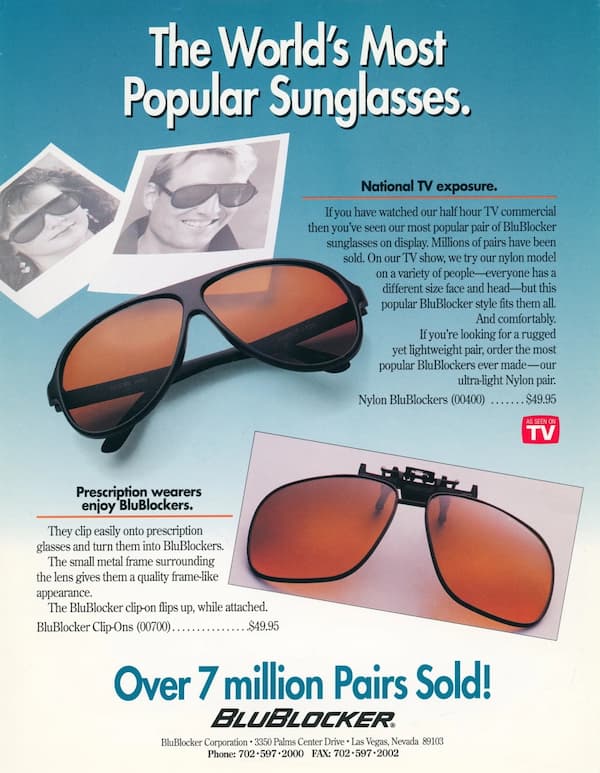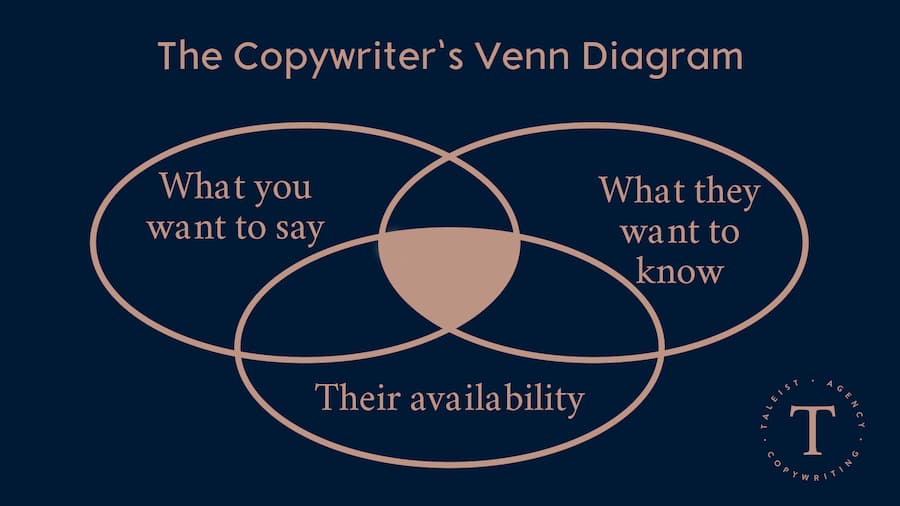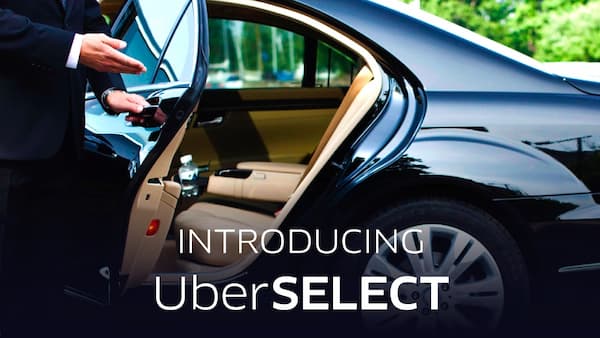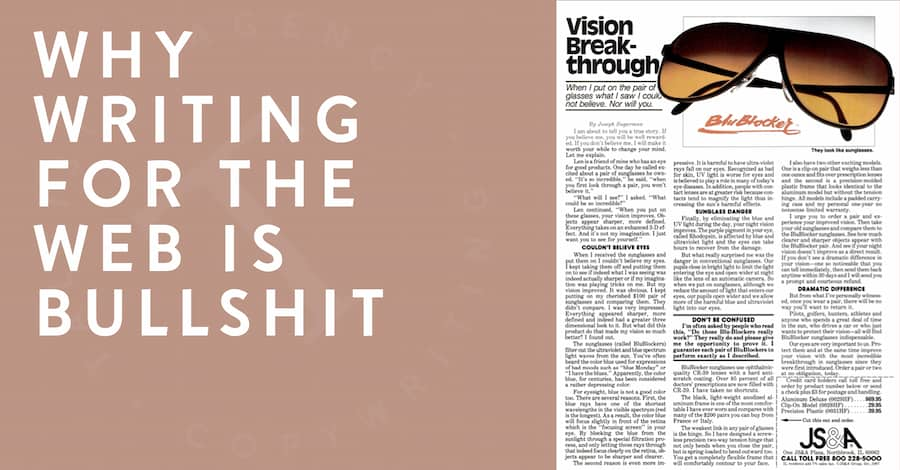10 copywriting tips for high-converting websites
Let’s be honest. Copywriting is hard.

Legendary copywriter Joe Sugarman sold 20 million pairs of BluBlocker sunglasses with newspaper ads. Clearly, he didn’t do that just by stringing a few pretty words together.
Today, we’d all love to replicate Sugarman’s ability to turn words into money. We’re just more likely to be applying our skills to effective website copywriting.
But how does one replicate old-school copywriting success in a website? These actionable copywriting tips will help. They go further than the usual web copy tips like “writer shorter sentences” and “remember that people skim websites”. But they’re all things a beginner copywriter can apply.
[toc]
What is website copywriting?
Website copywriting is persuasive writing for the web. But writing web copy is not so different from writing for email, direct mail or anything else. In fact, mastering the art of website copywriting involves learning best practices for writing copy in general. In this article, you’ll learn how to write persuasively for your target audience. (If you don’t want to learn yourself, we also have an article on how to choose a website copywriter.)
The difference between copywriting, content writing and SEO copywriting
First, it’s important to know that a website might comprise three kinds of writing:
- Copywriting
- Content writing
- SEO copywriting
Content writers: The difference between a copywriter and a content writer is what they need from readers. Content writing is the cornerstone of content marketing. The content writer writes relevant content to educate, to inform, to raise awareness.
Copywriters: A website copywriter writes for the same goals — education, information and entertainment. But a copywriter also has to persuade an ideal customer to take a desired action. Taking that desired action is the “direct response” in “direct response marketing“.
On a website the desired response might be clicking, calling, downloading, emailing or something else. Whatever the desired response, it’s more than being informed, educated or entertained.
SEO copywriting is a third kind of writing for websites. It’s different because SEO copywriting is about persuading search engines rather than a human being.
The SEO copywriter persuades Google that a website is the best answer to search queries. When that job is done, Google will send more readers to the website. That increased search engine traffic means more ideal customers are exposed to the website’s content writing and copywriting. For more, read our guide to SEO copywriting.
The tips that follow are for the copywriting on a website, the sections designed to get the idea customer to take action.
Tip 1: The copywriter’s Venn diagram
At the 50,000-foot view of any copywriting, there’s a Venn diagram. The copywriter’s Venn diagram covers three things…

1. What do you want to tell people?
We’re all fabulous at this part. We know EXACTLY what we want other people to know. We want you to know all the reasons why you should buy from us. We want you to know how you can make that purchase.
We will shout that information at you from our emails, our videos and our websites.
But telling people what we want them to know will go nowhere if that doesn’t overlap with…
2. What ideal buyers want to know
If you have low conversion rates and high bounce rates, you might be missing what your target audience wants to know. However, even the most interesting web copy needs to take into account…
3. How much time your reader has
The third set in your Venn Diagram is what your reader has time for right now. Ever had someone turn up for a 30-minute meeting with a 60-minute PowerPoint? You can’t tip a bucket of information into a thimble of willingness to listen.
Shoot for the overlap between all three sets of the copywriter’s Venn diagram to boost your conversion rate.
Tip 2: Never write a first draft
A prospective client sent me web copy he’d drafted for a new product. It had the facts. The grammar was correct. But the copywriting was fatally flawed.
Copywriting is about building desire and persuading the reader. This brochure was all facts, no desire or persuasion.
We fixed those problems easily over coffee, which is why this copywriting tip is…
“Write” your first draft out loud
The prospective customer started fixing the fatal flaws in his web copy from the moment we sat down over coffee. He just didn’t realise he was doing it.
Over coffee, he told me why he cared about what he was selling. He told me how far he’d traveled to find the right product. He talked about how many products he’d rejected in the search.
So why, I asked him, was none of that in his draft brochure?
In conversation, he’d convinced me effortlessly about himself and the product. But in writing he was reflexively serious. Writing does that to people. At the keyboard, people confuse “professional” with silted and boring. That’s why we recommend starting by talking, not writing. Here’s what you’re looking for:
- When you’re talking about your product or service, where do you start? Do you start by describing how finely your new pepper mill grinds pepper? Or do you start by talking about how fantastic food tastes with finely ground pepper? Trust your gut. Where you start in conversation with a friend is probably the most interesting part to a reader, too.
- What stories do you tell to illustrate the benefits of what you have? Every time I asked my prospective client a question, he answered with a story. ”Well, I found the answer to that when I visited this guy in Malaysia. ” So why was there not a single story in his website draft? The stories were so convincing, but they’d not made it into his writing.
Powerful language is more likely to come from taking than struggling over a first draft. And powerful writing is what a website needs.
Tip 3: Desire is rocket fuel for conversion rates
Desire is to copywriting what oxygen is to rocket fuel.
No one walks into a car dealership and asks which model will make them look the most successful — let alone the most virile. But no one spends $90,000 on a car because a Mazda wouldn’t hold the road well enough on the way to Woolies.
Focus your copywriting on your client’s real desires and you’ll see a difference in conversions. And that’s true in every business.
Focusing your copywriting on your clients’ desires isn’t always about naming those desires. It’s about your tone, your examples, your choice of words.

Uber nailed desire when they named a level of service “Uber Select”. They didn’t call the level “Uber You’ll Feel Better About Yourself Than You Will in a Yaris”. However, that’s what Uber Select meant.
Uber understands that the target customer for Select wants more than to get from A to B. Uber’s target customer desires to be seen as a “select” person. And by creating the Select category of vehicle, Uber gives them that chance.
Tip 4: Use your writing to let readers try before they buy
What’s the difference between these pieces of web copy for a Thai hotel?
Version one:
“Our lagoon-pool features a full bar service.”
Version two:
“Lounge by our lagoon pool, cooled by an Andaman Sea breeze. Sip Bacardi from a coconut while…”
I don’t know if people still drink Bacardi, but you get the point. Help your prospects imagine what will happen after they say yes, and they’re more likely to say yes.
In sales, this is called “future pacing”. And copywriting is sales in print. As your visitors mentally walk through your show home, tracing their fingers over the marble bench tops, they’re imagining your product in their lives. Once they own it in their minds, they just need to turn the imagery into a reality.
Future pacing is important for more than letting readers mentally try before they buy. Your readers have questions about what would happen next. If you’re not answering those questions, prospective customers might keep surfing until a competitor’s website tells them. Sometimes it’s the little details.
- How long will it take to arrive?
- How often will you need to use it?
- How long will it take to start working?
Tip 5: Children will make you better a better web copywriter
You know who can really help you with your copywriting? Your children. Don’t have children? Borrow some. Here’s why…
The goal with copywriting is to pitch your writing at a 12-year-old’s reading level. That’s not because your audience is 12 or has no more education than a 12-year-old. It’s because your audience is busy and distracted. And the chances are you’re interrupting them in the middle of something else.
You’re a distraction on top of a distraction. The less work it is to read what what you write, the more likely it is that your busy and distracted audience will take in your message.
Confused people stick with what they’re already doing. What they’re already doing is not buying from you.
If you don’t have a handy child at home, just imagine yourself talking to one.
Do they get what you mean when you invent a word like “learnings”? “Hey Jane, what were your learnings at school today?” Or would they use an actual word like “lessons”?
Do children LEVERAGE Instagram or do they just USE it? (Actually, they use Snapchat and TikTok, boomer, but you get the point.)
Ditch the industry jargon. Drop the marketing language. Stick to plain language and ideal buyers will thank you. That’s why no list of power words contains a word you’ll hear in a spelling bee.
Simple writing can be frightening because it gives us fewer places to hide by trying to look clever. Also, simple writing takes countless hours longer. But the effort will show up in your conversion rate.
Tip 6: Read the Daily Mail

It pains us to recommend the Daily Mail to anyone. But there is one good reason to read it: it will help your website copywriting.
The Daily Mail has been weathering the End Times for traditional media better than anyone could have expected. And it’s doing so because it understands online readers better than most. (And because it appeals to the bowels of the human spirit, but that’s another matter.)
Use of images is one of the many things the Daily Mail gets right about writing for websites. The Daily Mail maximises the use of image captions to get the message across.
Your ideal buyers skim websites, especially on their phones. But ideal buyers are like everyone else: their thumbs stop at pictures. Lean into the power of pictures by pairing them with captions packed with persuasive copywriting.
Tip 7: Tell your readers what you do
Do you want visitors to your website to contact you? If you do, there’s one thing you must do before anything else.
You need to tell your visitors what you do.
That sounds almost insultingly obvious. And yet, it’s crazy how many companies don’t say what they do. How many times have you arrived at a website and thought to yourself, I’m not sure these guys have what I need?
If you’re clear about what you do, your potential customers will have more confidence they’re in the right place. And the more confidence they have that you do what they want, the more likely they are to contact you.
Tip 8: Connect the features of your product or service to its benefits
Most websites concentrate on selling the features of their product or service — “fast”, “reliable”, “local”, “experienced”, etc.
You don’t use Uber because you want to drive around in someone else’s car. Riding in someone else’s car is a feature of ride-sharing. You take an Uber because you want to be somewhere else. That’s the benefit of ride-sharing apps. And the benefit is the part the reader cares about.
Look at your website right now. I’ll bet you’ll see many, many features of what you do. You’re professional; you’re passionate about customer service; you have 25 years of experience in the industry….
And I’ll also bet that no more than 20% of those features are tied to a benefit. Bt why would your customer care that you’ve been in the industry for 25 years? What benefits are they getting that they wouldn’t get from someone who’s been in the industry for 20 years?
Tip 9: Don’t miss out on FOBO
You’ve heard of fear of missing out. Now meet FOMO’s cousin…
The guy who coined FOMO also coined FOBO — the fear of better options. And your target audience has FOBO. That means your sales are suffering as a result.
So the fear of missing out is a marketer’s cattle prod…
“Tickets are selling out faster than an Instagram influencer…”
“Georgio will make only 200 of these cow scrotum clutches…”
By contrast, the fear of bettor options is like a handbrake on your sales. FOBO freezes prospects. They’re worried they’ll buy from you then find something better straight afterwards.
FOBO is why it takes you three apps, nine websites and a week of thinking to book a hotel room. Your first Google search threw up five perfect hotels, but you didn’t book. You worried that more searching would find the hotel that’s throwing in a million frequent flyer points or a butler.
Here are some ways to conquer FOBO with direct response website copywriting:
- Go long with your copywriting. If your prospect is worried your options aren’t good enough, you need to lay the options out exhaustively. Layer benefits upon benefits. Consider writing a special landing page designed to convert.
- Pivot to FOMO. If your prospect is waiting in case they find something better, terrify them about missing out if they don’t choose you.
- Induce urgency. Your prospect can’t stall if they don’t have time to delay. If the offer (or part of it) expires soon, your copywriting will focus the prospect’s mind on acting now.
- Make yourself scarce. Scarcity is another arrow in the heart of procrastination. Limited offers are another way to turn FOBO into FOMO.
- Guarantee it. Offer your FOBO-paralysed prospect a guarantee to salve their nerves. Once you’ve eliminated the risk of buying from you, your prospects can relax. (Also, they’re unlikely to take you up on the guarantee because they’ll stop shopping once they’ve seen how good you are.)
- Point out the cost of not working with you. “Every day you hesitate, you lose…” What do they lose? A month without a buyer’s agent costs thousands as house prices go up in the meantime? A month of no gym membership means another kilo of weight gain? Whatever it is, it has to be upsetting enough to compell a prospect to take action immediately.
Tip 10: A/B test your copywriting
Anclassic A/B test is where you present two groups of prospects with slightly different versions of marketing material. One group gets the A version. The other group gets the B version. For example, you try two versions of a headline to see which gets more clicks.
If you have 10,000 website visitors a day, you’ll have meaningful data in no time. For most businesses, it would take forever to find out if “discover more” converts better than “learn more”. However, that doesn’t mean you shouldn’t be A/B testing.
With lower traffic levels, you need to shelve the received wisdom. Be more sweeping in your tests. Rather than just changing the headline, you can completely change a landing page, for instance.
By making bolder differences between the A and the B version, you’ll get a sense of the broad direction you need to follow to get a higher conversion rate. And you’ll get that feedback faster than waiting months to find out which shade of green wins in a more traditional A/B test.
Start writing your persuasive copy today
These web copy tips are a start to writing high converting websites. As you practise, you’ll pick up more about what makes a good copywriter and great sales copy. However, when it comes to copywriting, one of the best tips I can leave you with is: Just start writing.
Learn to find the story, to write simply and not to fear the first draft. Then you’ll be ready to move on to learning copywriting formulas that work as well for digital content or full-page newspaper ads. And when you are ready to take your copywriting education up a notch..
